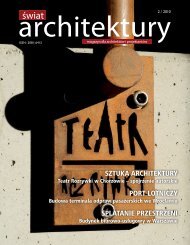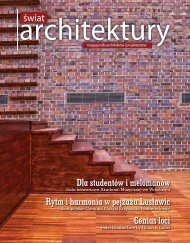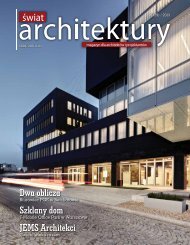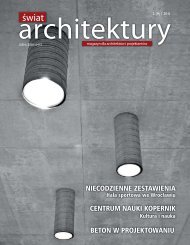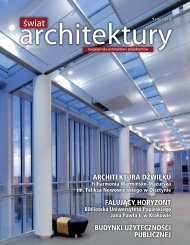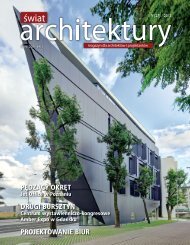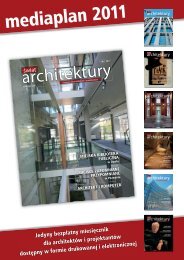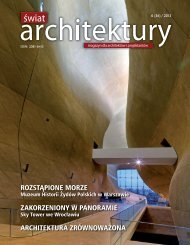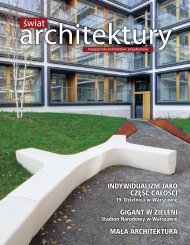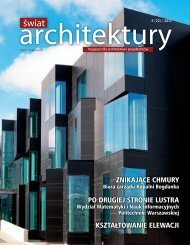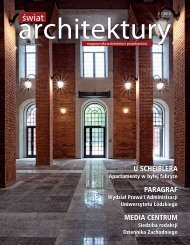swiat 21 - Świat Architektury
swiat 21 - Świat Architektury
swiat 21 - Świat Architektury
Create successful ePaper yourself
Turn your PDF publications into a flip-book with our unique Google optimized e-Paper software.
krążki do hokeja – istotny produkt eksportowy<br />
Czech. Tło jest białe, a z pustą przestrzenią<br />
publiczną – swoistą sceną, na której rozgrywają<br />
się relacje międzyludzkie – kontrastują kwartały<br />
zabudowy. Ta dwubiegunowość uwypukla się<br />
po zapadnięciu zmroku, gdy zmienia się wygląd<br />
elewacji. Kompozycja z hokejowych krążków,<br />
wystających – dzięki zamocowaniu na stalowych<br />
trzpieniach – ponad białe tło jest metaforą<br />
spojrzenia z szerokiej perspektywy na życie<br />
w centrum Europy, nacechowane wartościowymi<br />
efektami ludzkiej pracy.<br />
Poszczególne elewacje są widoczne<br />
z różnych dystansów – zwłaszcza główna,<br />
południowa. Dzięki temu zwiedzający może<br />
zorientować się w swoim położeniu na placu.<br />
Elewacja północna jest widoczna wyłącznie<br />
z podniesionego chodnika – „podniebnej kładki”<br />
(gra słów: sky – ang. niebo, walkway – ang.<br />
chodnik – red.). Tylko tutaj układ miasta można<br />
zobaczyć z góry. Elewacje wschodnia i zachodnia<br />
kontynuują motyw przewodni części głównej<br />
oraz mają okna i drzwi. Na południowej i północnej<br />
ścianie budynku umieszczono wykonane<br />
z plastiku napisy w języku czeskim i chińskim<br />
„Republika Czeska” – w kolorach niebieskim<br />
oraz czerwonym. Wraz z białym tłem kolory<br />
te symbolizują flagę Czech.<br />
Krążki hokejowe na nagwintowanych trzpieniach<br />
mocujących, tworzące bazowy element, są<br />
przykręcone do wkładek. Te z kolei są zamocowane<br />
do drewnianych paneli (z płyty wiórowej),<br />
z uprzednio przygotowanym rastrem, które<br />
mają białą powierzchnię, z delikatnie widocznymi<br />
łączeniami. Tak przygotowane panele są<br />
montowane za pomocą listew mocujących do<br />
wykonanej z blachy elewacji pawilonu. Dach<br />
pozostał niezmieniony w stosunku do pierwotnego<br />
projektu – jest niewidoczny z każdego<br />
miejsca terenu wystawowego.<br />
Ekspozycja<br />
Miasto, będące alegorią ludzkiej cywilizacji,<br />
jest zależne od surowców naturalnych. To<br />
miejsce życia, na które wpływ ma otaczający<br />
je krajobraz. Przypominamy o tym wzajemnym<br />
powiązaniu i zależności w układzie<br />
pawilonu – idąc wzdłuż falującego krajobrazu,<br />
symbolizującego podstawę cywilizacji, mając nad<br />
głową miasto – wznoszące się ponad otoczenie<br />
i całkowicie od niego zależne.<br />
Na wystawie pokazane są zdobycze cywilizacji,<br />
które ułatwiają nasz życie. Oprawiliśmy je<br />
w ramy lekkich sześcianów – tak jak architektura<br />
oprawia nasz świat.<br />
Dorobek cywilizacyjny może mieć zarówno<br />
pozytywne, jak i negatywne konotacje. Dostrzegamy<br />
to, dlatego wystawa dotyczy szerokiego<br />
polarity is emphasized by a contrast of the facade<br />
transformation after the nightfall.<br />
The complete composition of pucks presets<br />
before the white background of the pavilion by<br />
means of steel spines gives the facade a threedimensional<br />
look of living and valuable result of<br />
human work in the centre of Europe.<br />
Particular facades are perceived from various<br />
distances which - especially in case of the<br />
main southern facade - allows location in the<br />
area of the square. The northern facade can<br />
only be seen from the elevated walkway (so<br />
called "skywalk") and therefore only here we<br />
can see the city layout from above. Both the<br />
western and eastern facade follow-up to the<br />
main part and are supplemented by window and<br />
door openings. On the northern and southern<br />
facade plastic subtitles were placed in Czech<br />
and Chinese- in blue and red. Together with<br />
the white background these colors symbolize<br />
the Czech flag.<br />
Pucks on threaded spines, creating a preset<br />
structure, are simply screwed in the threaded<br />
inserts. These are attached to the wooden<br />
boards (such as chipboard) at the predetermined<br />
raster. The surface of the wooden boards is<br />
white (with slight raster). Pre-treated boards<br />
are then attached to the sheet metal facade of<br />
the pavilion by means of laths.<br />
The roof remains unchanged in the original<br />
design - it is not visible from any place of the<br />
exhibition area.<br />
Interior / Exposition<br />
The city representing a human civilization<br />
is dependant on natural resources. It is a place<br />
of life that interrelates with the surrounding<br />
landscape.<br />
In the Czech pavilion we remind this interconnected<br />
and unavoidable duality by the pavilion<br />
lay-out. We walk along the wavy landscape,<br />
representing an imaginary base of the civilization,<br />
having a town above us, rising out of the landscape<br />
and being completely dependent on it.<br />
In fact the town in the exposition consists of<br />
fruits of the civilization, facilitating our lives. These<br />
fruits of civilization are framed in suspended light<br />
cubes just as architecture frames our world.<br />
Civilization outputs are positive and negative<br />
by nature: We do not refuse this variance, the<br />
exposition moves between the wide scale of<br />
civilization positives and negatives. We respond<br />
to negative elements with a certain exaggeration,<br />
pointing out the possibility of changing the negatives<br />
to positives by human activity, by presenting<br />
the positive products of the Czech Republic.<br />
Visitors in the pavilion softly walk over the<br />
artificial grass, on a wavy terrain, comprising<br />
122 123



